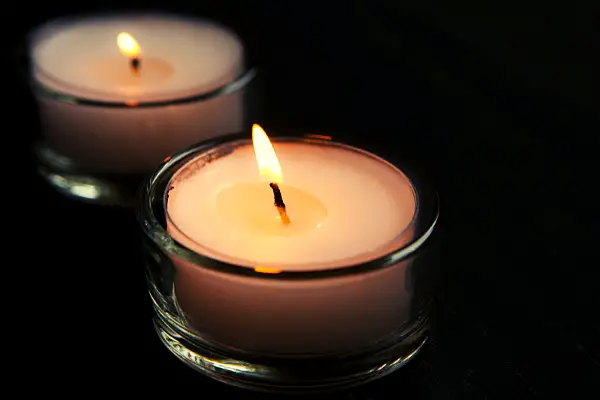If you’re a fan of lighting candles around your home, you’ve probably been in a situation where a candle you’re sure you put out suddenly got lit again. You’re positive that you took out the candle’s light, and all of a sudden, you find that it’s still lit. talk about being a spooky sight.
Or, maybe you’ve seen a party trick where a magician lit a candle smoke and the candle just started burning again. All of these can bring you to ask whether candles are capable of relighting themselves and burning again.

So, can candles light themselves? Actually, they can. A candle, even when blown out, can relight itself due to the residual heat of the wick if it gets a sufficient amount of oxygen. The warm wax releases vapour mixes with the oxygen and wick ember to reignite the candle, this produces the effect that the candle spontaneously combusted.
In this post, we’ll look at everything that concerns candles and the possibility of lighting themselves.
How Candles Actually Work
Candles are quite an impressive lighting system. They consist of two parts:
- The fuel, which is made of wax. Candle wax is actually flammable at certain temperatures.
- The wick, which absorbs the fuel itself.
In a candle, the wick will need to be naturally absorbent and is generally made from either cotton or wood. It will also need to have strong capillary action – which will allow the fuel to run through it quickly and moderately. Notice that if you get an unwaxed wick, it feels like a soft string. When you put it in water, it absorbs it pretty quickly. Absorption is very important when it comes to candles because you need the wick to absorb liquid wax, then move it forward while the candle burns.
The wax itself is a hydrocarbon that’s obtained from crude oil. When a candle is lit, the wax is melted and close to the wick.
The wick’s job is to absorb the wax – which is now liquid – and pull it up. With the heat from the flame, the wax is vaporized entirely. So, the part that burns is actually the wax vapor – not the wax itself.
As for why the wick doesn’t burn, this is because the wax will cool the exposed wick. Remember the trick of boiling water in a pepper cup? Even though it’s made of paper, the cup itself doesn’t burn because it is being cooled by the water in it. In the same way, liquid wax protects and cools the wick, thus preventing it from burning.
While the paraffin wax will burn on its own, you need to get it very hot before combustion can take place. Paraffin is hard to put out, meaning that only a small amount of wax on the wick is sufficient to burn.
How Do Candles Light Themselves?
let’s now take anlook at some of the ways that a candle could light itself.
Wind Action
You could have blown a candle out, but the wick’s ember remained hot enough. If this is the case and a slight wind blows, the candle could reignite itself. In some cases, the breeze created as you walk away from the candle alone is enough to light that ember and get the candle lit again.
It’s pretty much the same as trying to build a fire. You get a little fame going, then you blow on the embers to get the flame to spread across the fire’s base. By blowing on the embers, you’re delivering more oxygen to the fire and allowing the flame to grow. The same thing basically happens to candles.
Even more, keep in mind that wax vapor – which is flammable – is already present. So, you have oxygen, a fuel source, and some heat. That’s all you really need to get a flame going, and it increases the chance of the candle lighting on its own.
Concentrated sunlight
There has been recorded instances of candles in jars or glasses that have lit themselves.
If a candle is in a glass jar and placed in direct sunlight the glass can magnify the Suns heat and light causing extreme temperatures just like a magnifying glass.
This can cause the wax to melt and release its vapour and in extreme cause be hottest enough for the wick to heat and get an ember. Once that has happened Ed the candle can then light itself.
A Trick Candle
You could also purchase a trick candle by mistake. These trick candles are designed to light again after they’ve been blown out. They’re awesome for tricks and pranks, but you should also be careful about trick candles if you’re buying them.
Read the instructions on the candle so you know how to put it out. This way, you don’t risk a fire hazard or something else starting while you’re away. You should also be careful when kids are around.
A Simple Trick to Remember
If you’ve been to a party and a magician has done the whole candle relighting trick, then this is possibly the reason.
Most of these tricks include someone blowing a candle out, then holding their lighter to the smoke that comes out of it. Suddenly, the fire seems to travel through the smoke and back to the candle, causing it to light again. That could have gotten you as a kid, but you should know what’s going on.
Instead of smoke, what you actually saw was wax vapor – the flammable one. So, as soon as it was lit up, the fire simply moved through it like a conduit and got back to the candle.
There are a lot of instructional materials available on how to perform this trick. Maybe you could check some of them and give your younger cousins a treat when you all gather for the holidays. Just remember to be careful.
Conclusion
All in all, we’ve seen the different ways that a candle can relight itself. Whether it’s a simple trick, due to a hot ember and oxygen, or the flammable wax vapor, you could see candles light up by themselves.
In fact, you could simply be having a memory lapse where you thought you blew out a candle – only to remember later that you didn’t.
When using candles, you must stay careful and ensure that the candle is truly out when you’re leaving it alone. Blow it out consciously and wait for a minute or two to see if the ember remains lit. You can also put a lid on the candle, ensuring that it won’t reignite and you can rest easy knowing that your job is done.
- Can You Put Perfume In A Humidifier? (Read First) - September 17, 2022
- Can You Put Essential Oil In A Steam Mop? (Safety Advice) - September 17, 2022
- How To Make Lavender Oil At Home ( Candles And Diffusers) - September 9, 2022
